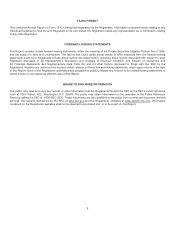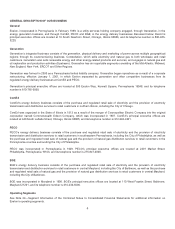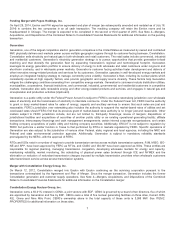Exelon 2014 Annual Report Download - page 19
Download and view the complete annual report
Please find page 19 of the 2014 Exelon annual report below. You can navigate through the pages in the report by either clicking on the pages listed below, or by using the keyword search tool below to find specific information within the annual report.The fuel costs per MWh for nuclear generation are less than those for fossil-fuel generation. Consequently, nuclear generation is
generally the most cost-effective way for Generation to meet its wholesale and retail load servicing requirements.
The cycle of production and utilization of nuclear fuel includes the mining and milling of uranium ore into uranium concentrates, the
conversion of uranium concentrates to uranium hexafluoride, the enrichment of the uranium hexafluoride and the fabrication of fuel
assemblies. Generation has uranium concentrate inventory and supply contracts sufficient to meet all of its uranium concentrate
requirements through 2016. Generation’s contracted conversion services are sufficient to meet all of its uranium conversion
requirements through 2015. All of Generation’s enrichment requirements have been contracted through 2020. Contracts for fuel
fabrication have been obtained through 2018. Generation does not anticipate difficulty in obtaining the necessary uranium
concentrates or conversion, enrichment or fabrication services to meet the nuclear fuel requirements of its nuclear units.
Natural gas is procured through long-term and short-term contracts, as well as spot-market purchases. Fuel oil inventories are
managed so that in the winter months sufficient volumes of fuel are available in the event of extreme weather conditions and during
the remaining months to take advantage of favorable market pricing.
Generation uses financial instruments to mitigate price risk associated with certain commodity price exposures. Generation also
hedges forward price risk, using both over-the-counter and exchange-traded instruments. See MANAGEMENT’S DISCUSSION AND
ANALYSIS OF FINANCIAL CONDITION AND RESULTS OF OPERATIONS, Critical Accounting Policies and Estimates and Note
12—Derivative Financial Instruments of the Combined Notes to Consolidated Financial Statements for additional information
regarding derivative financial instruments.
Power Marketing
Generation’s integrated business operations include the physical delivery and marketing of power obtained through its generation
capacity and through long-term, intermediate-term and short-term contracts. Generation maintains an effective supply strategy
through ownership of generation assets and power purchase and lease agreements. Generation has also contracted for access to
additional generation through bilateral long-term PPAs. PPAs, including tolling agreements, are commitments related to power
generation of specific generation plants and/or are dispatchable in nature similar to asset ownership depending on the type of
underlying asset. Generation secures contracted generation as part of its overall strategic plan, with objectives such as obtaining
low-cost energy supply sources to meet its physical delivery obligations to both wholesale and retail customers and assisting
customers to meet renewable portfolio standards. Generation may also buy power to meet the energy demand of its customers.
Generation sells electricity, natural gas, and related products and solutions to various customers, including distribution utilities,
municipalities, cooperatives, and commercial, industrial, governmental, and residential customers in competitive markets.
Generation’s customer facing operations combine a unified sales force with a customer-centric model that leverages technology to
broaden the range of products and solutions offered, which Generation believes promotes stronger customer relationships. This
model focuses on efficiency and cost reduction, which provides a platform that is scalable and able to capitalize on opportunities for
future growth.
Generation’s purchases may be for more than the energy demanded by Generation’s customers. Generation then sells this open
position, along with capacity not used to meet customer demand, in the wholesale electricity markets. Where necessary, Generation
also purchases transmission service to ensure that it has reliable transmission capacity to physically move its power supplies to
meet customer delivery needs in markets without an organized RTO. Generation also incorporates contingencies into its planning for
extreme weather conditions, including potentially reserving capacity to meet summer loads at levels representative of warmer-than-
normal weather conditions. Additionally, Generation is involved in the development, exploration, and harvesting of oil, natural gas
and natural gas liquids properties (Upstream).
Price Supply Risk Management
Generation also manages the price and supply risks for energy and fuel associated with generation assets and the risks of power
marketing activities. Generation implements a three-year ratable sales plan to align its hedging strategy with its financial objectives.
Generation also enters into transactions that are outside of this ratable sales plan. Generation is exposed to commodity price risk in
2015 and beyond for portions of its electricity portfolio that are unhedged. Generation has been and will continue to be proactive in
using hedging strategies to mitigate this risk in subsequent years. This strategy has not changed as a result of recent and pending
asset divestitures. As of December 31, 2014, the percentage of expected generation hedged for the major reportable segments was
93%-96%, 61%-64% and 31%-34% for 2015, 2016, and 2017, respectively. The percentage of expected generation hedged is the
amount of equivalent sales divided by the expected generation (which reflects the divestiture impact of Quail Run). Expected
generation is the volume of energy that best represents our commodity position in energy markets from owned or contracted for
15
























